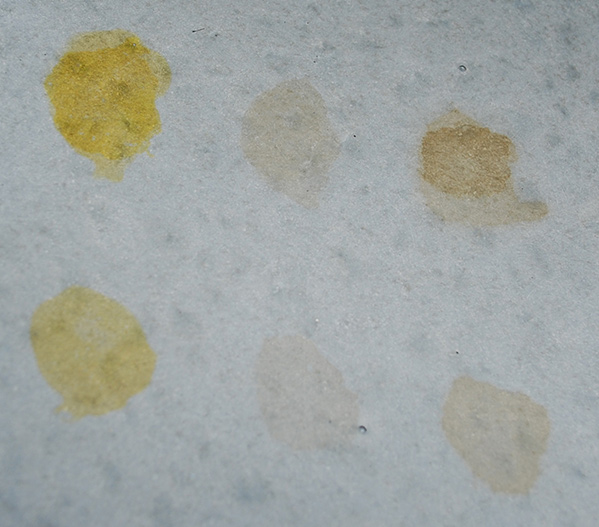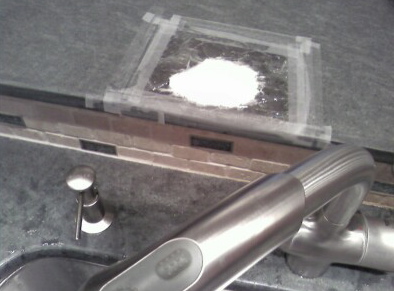If stains have occurred on your concrete countertop, all is not lost. The staining may be due to a poorly performing sealer not protecting the concrete, it could simply be temporary surface stains on a coating sealer, or it could be due to staining agents getting into scratches on a high performance coating sealer. In all cases, it is generally possible to bleach out stains in concrete.
Before embarking on removing stains, first evaluate the situation.
- Does the sealer appear to be undamaged, and therefore this is probably just a surface stain on the sealer itself? You may want to wet the surface of the sealer and see whether any water penetration occurs. If it does not, the sealer is likely intact, and you simply need to bleach out the surface stain.
- Does the sealer appear to be damaged, and the stain is in the concrete? If so, is the concrete simply discolored, or has the concrete been etched away by an acidic substance (it’s rough or pitted)? If the former, again the stain can be removed with bleach. If the latter, the concrete itself will need to be repaired before resealing, unless you want a rough spot to remain on your countertop.
- Has oil penetrated through a scratch and darkened the underlying concrete? If so, you must use a poultice to remove the oil. See below for oil removal.
Surface stains on a concrete countertop sealer:
Etched, stained concrete:
How to Bleach Out a Stain in Concrete
Stains (mustard, wine, etc.) can be bleached out using household bleach. If you are doing this on a sealed concrete surface, be sure to check first whether the sealer can withstand bleach. (Omega Concrete Countertop SealerTM is completely impervious to bleach.)
- Soak a folded paper towel or cotton ball with straight bleach and set it on the stain.
- Cover with a plate, cup, or glass to keep the bleach from drying out.
- Check the stain every 15 minutes until it’s disappeared.
- Clean up with water and a mild cleaner like Windex.
- Allow the area to completely dry out.
This simple process, while more complex than just spraying on and wiping off a household cleaner, is an easy way to restore the appearance of your concrete countertop.
After the stain is removed, you may repair scratches in or reseal the concrete countertop according to the instructions provided by the manufacturer of whatever sealer you have chosen. Click here for the scratch repair process for Omega Concrete Countertop Sealer, and click here for the resealing process.
How to Remove Oil from Concrete
If oil has soaked into concrete, it must be drawn out with a poultice. The most effective poultice is made with baking soda (sodium bicarbonate) and acetone. Before attempting this, make sure that your sealer can withstand acetone. (Omega Concrete Countertop SealerTM is completely impervious to acetone.)
Poultice of Baking Soda and Acetone:
- Add enough acetone to baking soda to make a paste.
- Thickly smear it over the oil stain.
- Cover and tape down plastic wrap to prevent the acetone from evaporating.
- Allow the poultice to sit overnight and draw the oil out.
- The process may need to be repeated to eliminate as much oil as possible. Bear in mind you may not be able to get all of the oil out of the concrete.
If your sealer cannot withstand acetone, you can try the same technique with just baking soda, but be aware that there is no evaporative agent to draw the oil out, and you might not be able to remove the oil. You can also try a good grease-cutting cleaner such as Dawn brand dish detergent.
If you are not able to remove oil using any of these methods, the best course of action would be to completely remove the sealer, then use a baking soda/acetone poultice to remove the oil, then reseal the concrete.
If Resealing is Needed
Follow the instructions in this article: “How to Reseal Concrete Countertops”.



